Instructions for the Backward
Loop Cast On can be found here.
Information about felting can be found here.
Instructions for Backstitch can be found here
Instructions for working mattress stitch horizontally can be
found here (see Shoulder Seams):
Matching the given gauge is not essential. However, it is important that your stitches are not too tight (they will tighten up with felting) or too loose (we dont want to see any stuffing showing through).
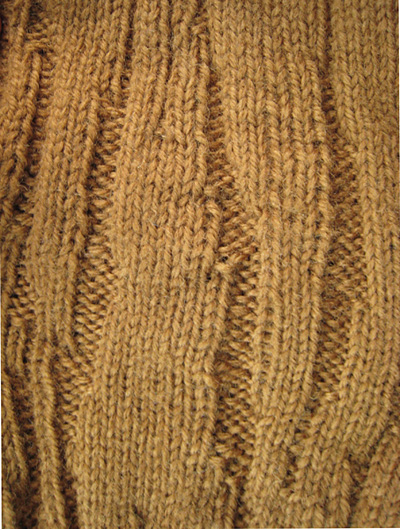  Bark
Pattern Bark
Pattern
This pattern involves some freestyle purling to achieve the bark-like effect of the log.
In the first round of the Bark Pattern, intersperse purl stitches, singly and in pairs, among the knit stitches in a random fashion. For example, your round might begin k6, p1, k10, p1, k7, p2, k14, p1
In subsequent rounds, continue to work vertical purl ribs
as established, but with slight random variations.
Make your
ribs alternately wider or narrower by adding or subtracting
purl stitches, insert knit stitches among your purl stitches
to make one rib split into two, etc. Just make sure that
you're not doing more purling in a round than knitting
the knit stitches will make an even surface on which to
later embroider the spooky eyes.
The most important thing is to have fun with trying different
variations, and not to over-think it! It’s surprising
to see how much what seems like a mess of random purling
at the time turns into something that looks like tree bark
once its finished.
|
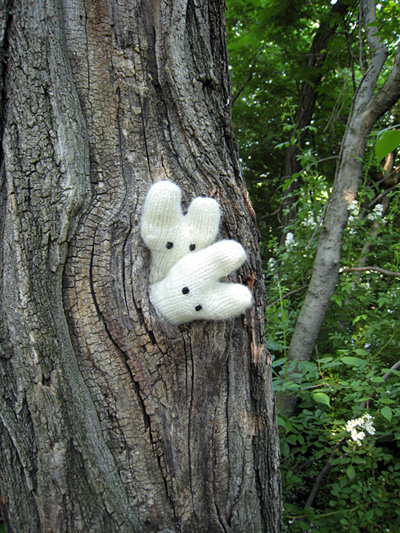  WOODIN (one skein of yarn will make up to 5) WOODIN (one skein of yarn will make up to 5)
First Foot:
Using color A, CO 4 sts. Divide sts between 3 double-point needles and join to begin working in the round, being careful not to twist.
Round 1: [Kfb] 4 times. 8 sts.
Round 2: K all sts.
Round 3: K1, [kfb] twice, k2, [kfb] twice, k1. 12 sts.
Round 4: K all sts.
Break yarn and securely weave in the ends. Place these sts on spare double-point needles, and set aside.
Second Foot:
Work as for First Foot until Round 4 is complete.
Join Feet:
Next Round: K first 6 sts of Second Foot onto one needle, continuing with same needle CO 2 sts using backward loop method, k first 2 sts of First Foot; using second needle, k next 4 sts of First Foot, place marker, k following 4 sts; using third needle, k remaining 2 sts of First Foot, CO 2 sts, k remaining 6 sts of Second Foot. 28 sts.
As work progresses, redistribute sts as desired, but keep marker and end of round in same location.
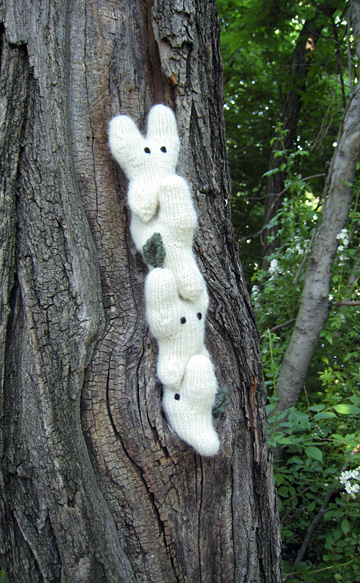  Body Body
Round 1: K all sts.
Even-numbered Rounds 2-22: K all sts.
Round 3: K1, k2tog, k to 3 sts before marker, ssk, k2, k2tog, k to last 3 sts, ssk, k1. 24 sts.
Round 5: Work as for Round
3. 20 sts.
Odd-numbered Rounds 7-11: K all sts.
Round 13: K1, kfb, k to 2 sts before marker, kfb, k2, kfb, k to last 2 sts, kfb, k1. 24 sts.
Round 15: Work as for Round
13. 28 sts.
Round
17: K all sts.
Round 19: Work as for Round
13. 32 sts.
Round 21: K all sts.
Round 23: K1, k2tog, k2, ssk, k1; place next 16 sts on st holder or waste yarn; k1, k2tog, k2, ssk, k1. 12 sts. These 12 sts will form one ear.
Rounds 24-30: K all sts.
Break yarn and draw through remaining 12 sts, pull tight.
Second Ear:
Replace held sts on double-point needles and rejoin yarn at point next to first ear.
Next Round: K1, k2tog, k2, ssk, k2, k2tog, k2, ssk, k1. 12 sts.
K 11 rounds. The second ear will be longer than the first.
Break yarn and draw through remaining 12 sts, pull tight.
LEAF (Make one for the tail of each creature, and three for
the log.)
Using color B, CO 2 sts. Leaf is worked back and forth.
Row 1 [RS]: K2.
Odd-numbered Rows 2-10 [WS]: P all sts.
Row 3 [RS]: [Kfb] twice. 4 sts.
Row 5 [RS]: K1, [kfb] twice, k1. 6 sts.
Row 7 [RS]: K all sts.
Row 9 [RS]: [K2tog] 3 times. 3 sts.
When Row 10 is complete, break yarn and draw through
remaining 3 sts, pull tight.
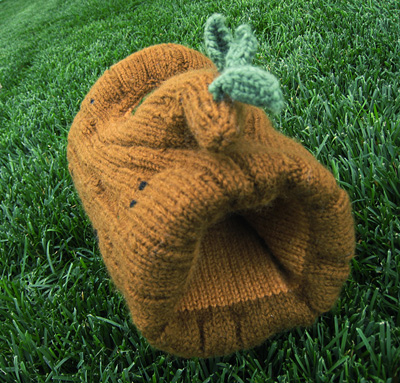  LOG LOG
Using Color C, CO 80 sts onto double-point needles or
circular needle. If using double-point needles, divide
sts between 3 needles. Join to work in the round, being
careful not to twist.
K 1 round.
Next Round: [K3, kfb] to end. 100 sts.
K 2 rounds.
Work 20 rounds in Bark Pattern.
Shape Hole:
Note: While shaping the Hole, the piece will be worked
back and forth.
Row 1 [RS]: K1, [k2tog] twice, work in pattern to last
5 sts, [ssk] twice, k1. Turn work. 96 sts.
Even-numbered Rows 2-24 [WS]: Work in pattern as set.
Odd-Numbered Rows 3-7 [RS]: Work as for Row 1. 84 sts
when Row 7 is complete.
Odd-numbered Rows 9-11 [RS]: K1, k2tog, work in pattern
to last 3 sts, ssk, k1. 80 sts when Row 11 is complete.
Row 13 [RS]: Work in pattern as set.
Odd-numbered Rows 15-17 [RS]: K1, kfb, work in pattern
to last 2 sts, kfb, k1. 84 sts when Row 17 is complete.
Odd-numbered Rows 19-25 [RS]: K1, [kfb] twice, work in
pattern to last 3 sts, [kfb] twice, k1.
When Row 25 is complete, there are 100 sts. Do not turn
work at end of this round; rejoin piece to work in the
round.
Work 25 rounds in pattern.
Shape Branch:
Note: If you have been working the log on a circular
needle, the sts which will be placed on hold in the next
round do not needle to be removed from the circular needle;
just slip the last 10 sts of the round to a double-point
needle before working them.
Branch is worked in stockinette st.
Next Round: Using double-point needles, work 10 sts in
pattern, place next 80 sts on st holder or waste yarn,
work remaining 10 sts in pattern. 20 sts.
Divide sts evenly between needles and work in the round
as follows:
K 4 rounds.
Next round: [K2tog, k2] to end. 15 sts.
K 6 rounds.
Next round: [K2tog, k1] to end. 10 sts.
K 6 rounds.
Break yarn and draw through remaining sts, pull tight.
Continue Log:
Replace held sts on double-point needles and reattach
yarn.
Work 18 rounds in pattern as set.
K 2 rounds.
Next Round: [K2tog, k2] to end. 60 sts. Break Color C.
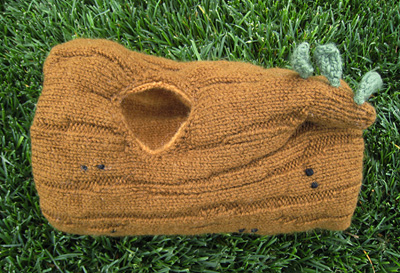  Log Lining: Log Lining:
Note: This lining will later be turned to the inside
of the log and sewn in place.
Using Color D, k 18 rounds.
Next Round: [Kfb, k2] to end. 80 sts.
K 25 rounds.
Shape Hole:
Row 1 [RS]: K1, [k2tog] twice, k to last 5 sts, [ssk]
twice, k1. Turn work. 76 sts.
Even-numbered Rows 2-24 [WS]: P all sts.
Odd-Numbered Rows 3-7 [RS]: Work as for Row 1.
64 sts
when Row 7 is complete.
Odd-numbered Rows 9-11 [RS]: K1, k2tog, k to last 3 sts,
ssk, k1. 60 sts when Row 11 is complete.
Row 13 [RS]: K all sts.
Odd-numbered Rows 15-17 [RS]: K1, kfb, k to last 2 sts,
kfb, k1. 64 sts when Row 17 is complete.
Odd-numbered Rows 19-25 [RS]: K1, [kfb] twice, k to last
3 sts, [kfb] twice, k1.
When Row 25 is complete, there are 80 sts. Do not turn
work at end of this round; rejoin piece to work in the
round.
K 20 rounds.
BO all sts.
|

